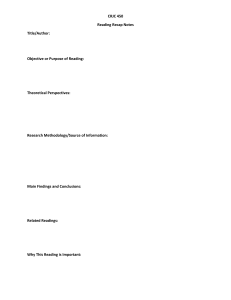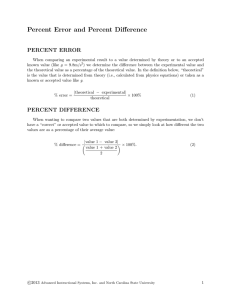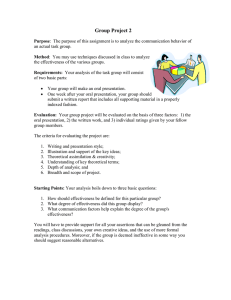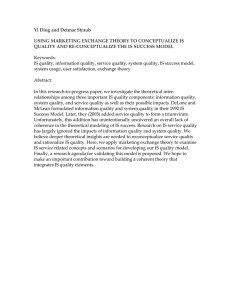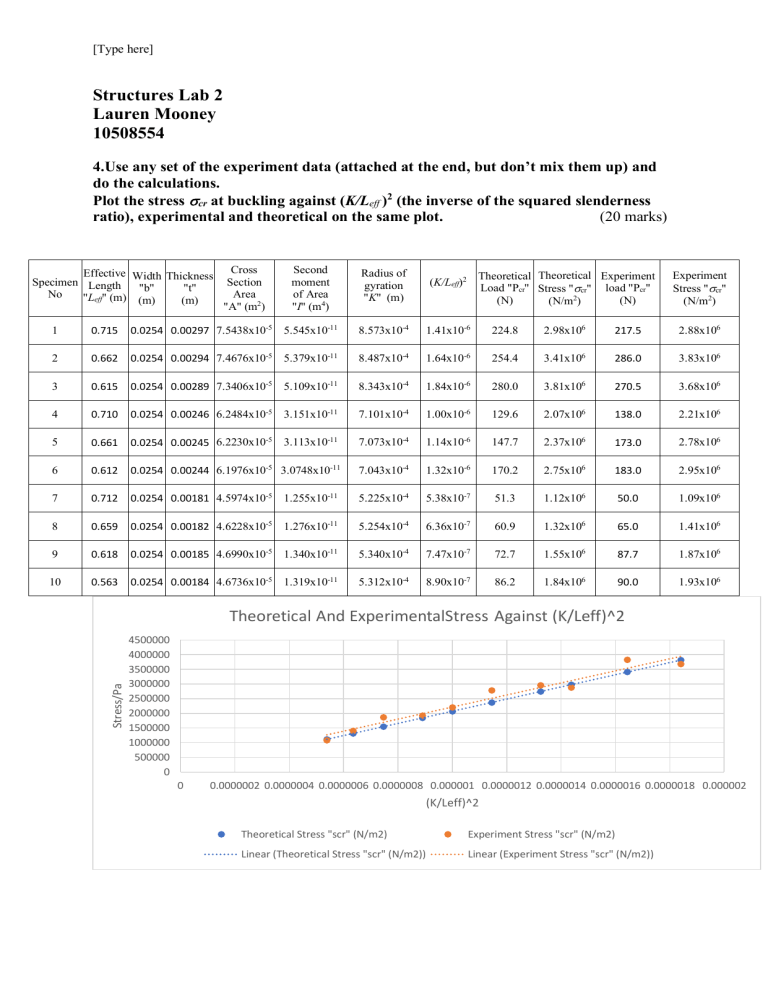
[Type here] Structures Lab 2 Lauren Mooney 10508554 4.Use any set of the experiment data (attached at the end, but don’t mix them up) and do the calculations. Plot the stress cr at buckling against (K/Leff )2 (the inverse of the squared slenderness ratio), experimental and theoretical on the same plot. (20 marks) Effective Width Thickness Specimen Length "b" "t" No "Leff" (m) (m) (m) Cross Section Area "A" (m2) Second moment of Area "I" (m4) Radius of gyration "K" (m) (K/Leff)2 Theoretical Theoretical Experiment Load "Pcr" Stress "cr" load "Pcr" (N) (N) (N/m2) Experiment Stress "cr" (N/m2) 1 0.715 0.0254 0.00297 7.5438x10-5 5.545x10-11 8.573x10-4 1.41x10-6 224.8 2.98x106 217.5 2.88x106 2 0.662 0.0254 0.00294 7.4676x10-5 5.379x10-11 8.487x10-4 1.64x10-6 254.4 3.41x106 286.0 3.83x106 3 0.615 0.0254 0.00289 7.3406x10-5 5.109x10-11 8.343x10-4 1.84x10-6 280.0 3.81x106 270.5 3.68x106 4 0.710 0.0254 0.00246 6.2484x10-5 3.151x10-11 7.101x10-4 1.00x10-6 129.6 2.07x106 138.0 2.21x106 5 0.661 0.0254 0.00245 6.2230x10-5 3.113x10-11 7.073x10-4 1.14x10-6 147.7 2.37x106 173.0 2.78x106 6 0.612 0.0254 0.00244 6.1976x10-5 3.0748x10-11 7.043x10-4 1.32x10-6 170.2 2.75x106 183.0 2.95x106 7 0.712 0.0254 0.00181 4.5974x10-5 1.255x10-11 5.225x10-4 5.38x10-7 51.3 1.12x106 50.0 1.09x106 8 0.659 0.0254 0.00182 4.6228x10-5 1.276x10-11 5.254x10-4 6.36x10-7 60.9 1.32x106 65.0 1.41x106 9 0.618 0.0254 0.00185 4.6990x10-5 1.340x10-11 5.340x10-4 7.47x10-7 72.7 1.55x106 87.7 1.87x106 10 0.563 0.0254 0.00184 4.6736x10-5 1.319x10-11 5.312x10-4 8.90x10-7 86.2 1.84x106 90.0 1.93x106 Stress/Pa Theoretical And ExperimentalStress Against (K/Leff)^2 4500000 4000000 3500000 3000000 2500000 2000000 1500000 1000000 500000 0 0 0.0000002 0.0000004 0.0000006 0.0000008 0.000001 0.0000012 0.0000014 0.0000016 0.0000018 0.000002 (K/Leff)^2 Theoretical Stress "scr" (N/m2) Experiment Stress "scr" (N/m2) Linear (Theoretical Stress "scr" (N/m2)) Linear (Experiment Stress "scr" (N/m2)) [Type here] 5. Compare the experimental results with the theoretical predictions. (Reasons are not needed, they are required in the next question) (20 marks) As you can see in the graph, the line of best fit for both theoretical and experimental stresses have similar gradients which indicates the as the (K/Leff)2 increases both Stresses also increase at a similar rate to each other. However the line of best fit for experimental results is slightly higher than the best fit for theoretical stresses indicating that the values for experimental stresses are higher than values for theoretical As you can see for the blue theoretical value lines, the plotted points are all along the line of best fit where as the yellow plotted points are quite sporadic in that they could be a lot higher or lower than the line of best fit. 6.There are many probable sources of error which affects the experimental results. List (a) One source which makes the experimental result higher than the theoretical prediction. The outcome of experimental values could be larger than theoretical if increment of the weights used were too large. (eg. If a weight of 1Kg was added when a load of 0.25Kg would result in the column buckling). This is because the column will not buckle until Pcr is achieved which means if P>Pcr it will also buckling allowing the value of Pcr to be misjudged to be higher than theoretical. (b) Two sources which make the experimental result lower than the theoretical prediction. One source that would make the experimental result lower than the theoretical is if in the beginning there may have been a small force applied to the column before any weights are added. Another source would be if the material was already deformed before the column undergoes the compression. This may lead the material to buckle prematurely which will therefore make the experimental results smaller than the theoretical. (c) Two sources which may affect the experimental results randomly (sometimes higher, sometimes lower). Human error could be the cause of the experimental results to produce a higher or lower value compared to the theoretical value. This involves misreading the lengths of columns. 7. Is there any major merit in plotting cr ~ (K/Leff)2 rather than Pcr ~ I/Leff2 to show the buckling behaviour of columns under axial compression? Give reasons. (12 marks) After plotting this graph, you can see a similar trend in that both graphs show lines of a similar positive gradient. Although they show similar results in terms of trend, I believe that the graph of cr ~ (K/Leff)2 as it takes into consideration of more factors than the graph of Pcr ~ I/Leff2 (ie, cross sectional and second moment area) and therefore provides a better presentation of the information calculated. [Type here] 8. Application of buckling theory to structural failure analysis (33 marks) A pin-jointed truss structure is loaded by three forces as shown below. The bars are made of the same material of Young’s modulus E=210GPa and a permissible stress =200MPa. All the bars have a solid circular cross-section of a radius r= 0.01 m. The length of the diagonal bars is a = 0.5m. Assuming bars under compression can be considered as simply supported columns (therefore Euler formula for buckling load Pcr = 2EI / L2can be used). Determine the maximum value of load W which will not cause the failure of the structure. 2W 6W B a A 45 D a a 45 45 C a 45 E 3W [Type here] [Type here] N

